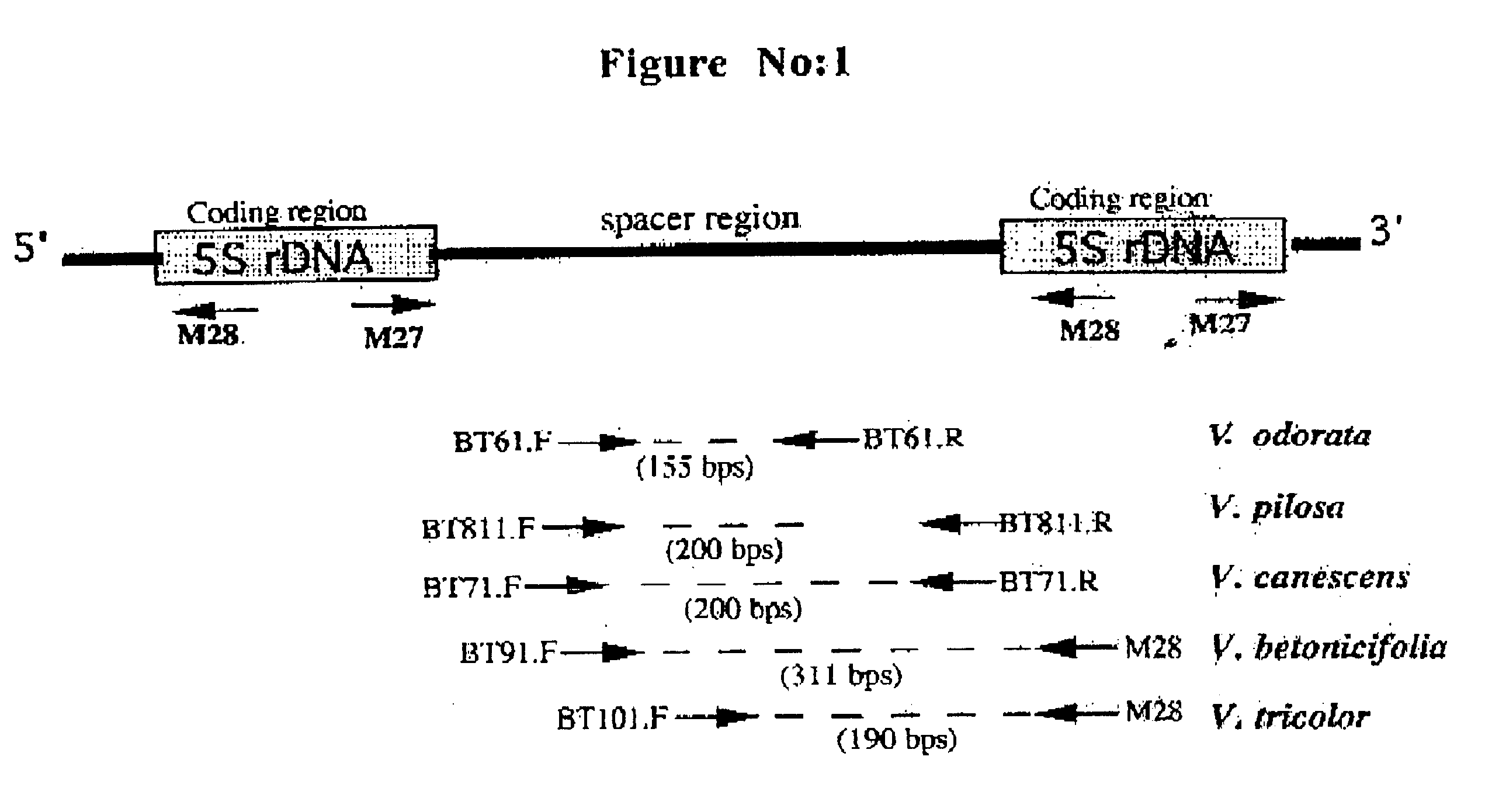Species specific DNA sequences and their utilization in identification of viola species and authentication of "banafsha" by polymerase chain reaction
a viola species and dna sequence technology, applied in the field of species specific dna sequences, can solve the problems of difficult identification of plant species by morphological, little value of markers, and interference in identification, and achieve the effect of sensitive, accurate and efficient methods
- Summary
- Abstract
- Description
- Claims
- Application Information
AI Technical Summary
Benefits of technology
Problems solved by technology
Method used
Image
Examples
example 2
Conserved 5S rRNA gene based primers (3' and 5') gave an identical amplification product in a population of 28 individual plants of Viola pilosa:
In order to find out 5S rRNA associated spacer length and sequence variability within the individuals of a species, the applicants analyzed 28 individuals plants of V. pilosa selected randomly from 2 plots (from IHBT campus, Palampur and Jogindernagar Herbal Garden, Jogindernagar), for their amplification products using consensus 5S rRNA primers M27 and M28. As shown in FIG. 4A, all the plants gave identical banding patterns. When these plants were subjected to RAPD analysis using OPE-09 primer they again showed identical banding patterns (FIG. 4, panel B). When 2 more primers were analyzed they showed some differences in many of the plants as expected (data not shown).
example 3
Viola betonicifolia specific primers gave an identical amplification product in 12 individual plants collected from nature:
Similar to example 1, 12 individual plants of V. betonicifolia were analyzed for their amplification products using V. betonicifolia species specific set of primers (BT91.F and M28 as illustrated in FIG. 2). As shown in FIG. 5A1, all the plants gave identical banding patterns. These PCR products when denatured and analyzed in a I.8% agarose gel again revealed identical banding patters (FIG. 5, panel A2). When these plants were subjected to RAPD analysis using OPE-09 primers they showed little differences, for example, in lane no 2 and 3 the 3.sup.rd band from top is present only in 4 samples which is different in size in lane number 8 (FIG. 5, panel B).
example 4
Market samples of banafsha revealed that majority of them were fake samples:
In order to find out the genuineness of banafsha, the applicants analyzed 18 market samples of banafsha collected from different markets during 1997-99 for their amplification products using V. canescens specific primers. FIG. 6 shows that 7 samples were positive for V. canescens which does not represent genuine banafsha. This example clearly demonstrate that the developed PCR band approach works well for market samples.
The main advantages of the present invention are:
PUM
| Property | Measurement | Unit |
|---|---|---|
| temperatures | aaaaa | aaaaa |
| temperatures | aaaaa | aaaaa |
| temperatures | aaaaa | aaaaa |
Abstract
Description
Claims
Application Information
 Login to View More
Login to View More - R&D
- Intellectual Property
- Life Sciences
- Materials
- Tech Scout
- Unparalleled Data Quality
- Higher Quality Content
- 60% Fewer Hallucinations
Browse by: Latest US Patents, China's latest patents, Technical Efficacy Thesaurus, Application Domain, Technology Topic, Popular Technical Reports.
© 2025 PatSnap. All rights reserved.Legal|Privacy policy|Modern Slavery Act Transparency Statement|Sitemap|About US| Contact US: help@patsnap.com



